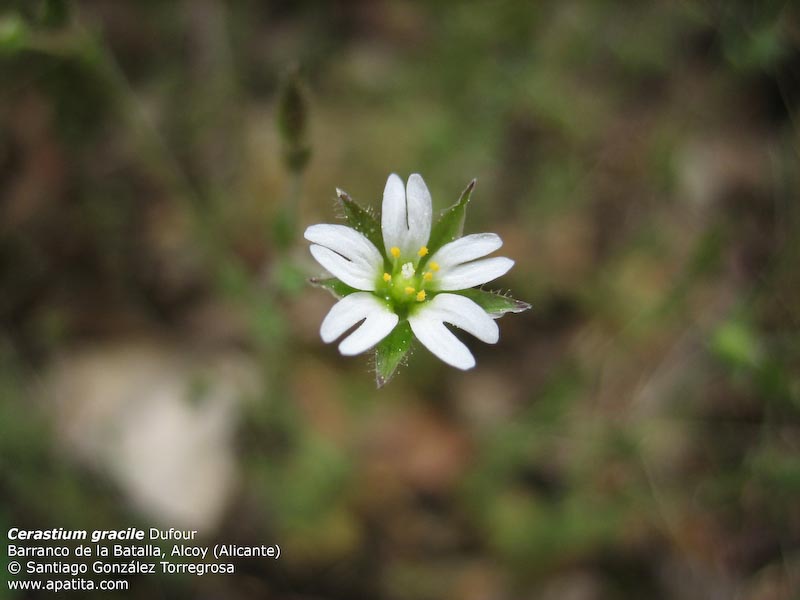Cerastium
|
Family: Caryophyllaceae |
Herbs, annual, winter annual, or perennial. Taproots slender, perennial taxa often rhizomatous, rooting at nodes. Stems ascending to erect or decumbent, simple or branched, terete. Leaves basally connate, petiolate (basal in some species) or sessile (cauline); blade 1-5-veined, linear or elliptic to broadly ovate, not succulent (except in C. bialynickii, C. regelii, and C. viride), apex acute to obtuse. Inflorescences terminal, open or congested cymes, or flowers solitary, axillary (racemosely arranged in C. axillare); bracts paired, foliaceous or reduced, herbaceous or often with scarious margins. Pedicels erect, sometimes reflexed or hooked at apex in fruit, or flowers sometimes subsessile (C. regelii). Flowers bisexual, occasionally unisexual and pistillate; perianth and androecium hypogynous or weakly perigynous; hypanthium minimal; sepals (4-)5, distinct, green (red-tipped in C. glomeratum and C. pumilum, often violet-tipped in C. alpinum, purple in C. bialynickii, turning pale orange-brown in fruit in C. texanum), elliptic to ovate, 3-12 mm, herbaceous, margins translucent to purplish, scarious, apex acute, acuminate, or obtuse, not hooded; petals (4-)5 or sometimes absent, white (purple tinged in C. pumilum and C. regelii), clawed, blade apex 2-fid 1/ 1/ 2 of length, notched, or emarginate; nectaries at base of filaments opposite sepals; stamens usually 10, sometimes 5 or 8, occasionally 4; filaments distinct, inserted at base of ovary; staminodes absent or 1-4 (via anther abortion), linear; styles (3-)5(-6), clavate to filiform, 0.5-2 mm, glabrous proximally; stigmas (3-)5(-6), subterminal to linear along adaxial surface of styles, roughened to papillate (30×). Capsules oblong or cylindric, usually ± curved, opening by 10, or occasionally 6 or 8, erect or spreading, convolute or revolute teeth, longer than sepals; carpophore absent. Seeds 15-150+, orange to brown, angular-obovate, often with abaxial groove, laterally compressed, papillate-tuberculate, marginal wing absent, appendage absent. x = [9-, 13, 15] 17, 18, 19. As in terminal cymes, or sometimes solitary; sep (4)5; pet (4)5, retuse to bifid or seldom entire, or occasionally wanting; stamens (4-)10; styles (3-)5; capsule usually surpassing the sep, cylindric, membranous, often curved, dehiscent by (6-)10 short apical teeth; seeds numerous, obovate-reniform, dorsally grooved, papillate-tuberculate; low annual or perennial herbs with rather small, opposite, exstipulate lvs. 100, widespread. Gleason, Henry A. & Cronquist, Arthur J. 1991. Manual of vascular plants of northeastern United States and adjacent Canada. lxxv + 910 pp. ©The New York Botanical Garden. All rights reserved. Used by permission. |

